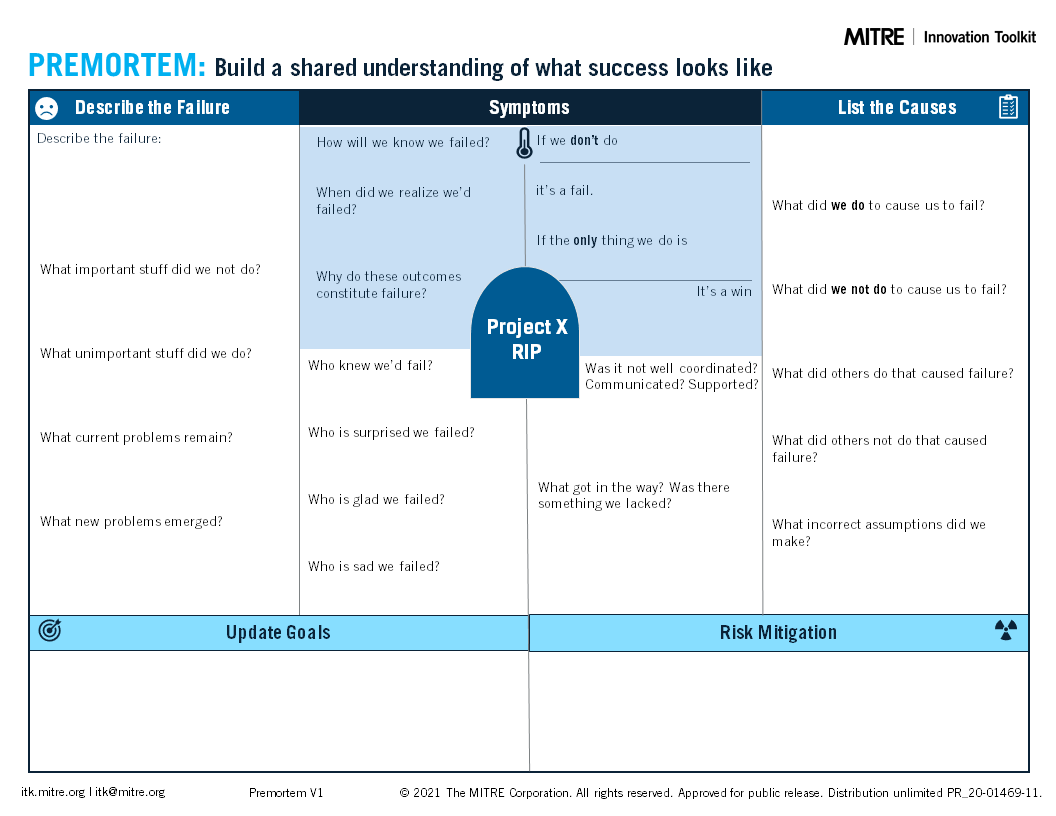
‘In a premortem, team members assume that the project they are planning has just failed—as so many do—and then generate plausible reasons for its demise.’ Harvard Business Review
Do you know the differences between project pre and post-mortems? Projects commonly have a post-mortem to assess the successes and the could-do-betters at the end of a project. But what about risk assessments before you begin, are they essential, nice to haves or inconsequential?
In the article, we’ll discuss what premortems are, why you need them, and tips for carrying them out.
What is a project premortem?
Before you start a project (or in the middle of a project pre-completion), you can carry out a premortem with your team to discuss what could work well and potentially go wrong or present challenges. This is really helpful to envisage roadblocks and risks and improve the process by looking ahead.
Ideally, you need the entire project team to participate in the premortem to give as many different perspectives as possible, and often, meetings will be led by the project manager.
According to d.lab, by imagining an event that has already happened it, ‘Increases the ability to correctly identify reasons for future outcomes by 30%.’ You can view their premortem template here.

Aren’t premortems just rebranded risk assessments?
In some ways, yes. Risk assessments are more formal, as risks are identified and then monitored using a risk register. The advantage is the risk register will already have risks and potential solutions in place, so you can call upon it if the risk becomes a reality.
During a premortem, however, risks are speculated on, and it’s assumed that the project in question has already failed or died. Therefore, the risk analysis is done before the project commences and allows individuals to use knowledge and experience of past projects to highlight potential risks.
In the words of CTO Craft founder Andy Skipper, ‘In my experience, premortems tend to be a little more organic and conversational, whereas risk assessments are more mechanical and impersonal.’
Nicola Sedgwick, a people-focused technology leader and agile coach, is familiar with project premortems. She says at Cazoo, they didn’t refer to them as risk assessments, but instead, ‘We sometimes did kickoffs with a premortem element included rather than purely doing premortems.’
What about project bias?
Without a pre-planning discussion session (or more than one) before a project commences, is there the possibility that bias could interfere with project reality?
According to Forbes, bias is a real risk if preplanning does not occur. For instance, project leaders/managers may be overly confident about project risks, reality, costs and success leading to failure. They call this ‘overconfidence bias.’
Alternatively, they suggest that ‘ambiguity aversion’ may occur where potential issues or concerns are dismissed because there is little prior knowledge or experience of them.
Finally, they question the potential of ‘planning fallacy’ which is the ‘tendency to structurally underestimate the time and budget needed to get something done’.
So, could all these biases be challenged during a project premortem?
If it’s good enough for PayPal
A few years ago, PayPal introduced project premortems. Their approach was to ask an engineer to write a ‘user story’ to describe possible problems and solutions. Next, the team discussed the perceived issues and outcomes in a premortem, and afterwards, the engineer made the relevant design changes.
Their process was beneficial because it encouraged several individuals to spot issues and highlight blind spots early on. It was also a way for less experienced team members to be part of an important learning exercise and allowed participation and involvement by all team members.
Encourage psychological safety
Pre-project reviews may enhance psychological safety because of the culture of normalising discussions about failure. Or perhaps it’s the other way around, and existing psychological safety within a project group can encourage a more honest and open conversation about project risks.
Sedgwick says that there are some critical factors to get right with premortems, ‘You need a high degree of psychological safety. People need to feel safe to speak up without fear of reprimand, belittling or being told off for bringing doubt to the mission. No topic should be off the table.’
‘Let people be imaginative, let them be absurd. It is better to discuss and discount things than to not surface them.’
Find new ways to assess risk
Another option is to create a diverse project team and be clear about the objectives before you kick off—that you need to identify potential project challenges and risks before strategy implementation. You can use a worksheet or template to structure the discussion and record input.
You can then discuss with the group a hypothetical scenario where the strategy has failed and ask every person to write down what reasons there could be for failure. Then, you can ask each person to read out their reasons and allow these to start an open conversation among the group.
Not only will this allow many suggestions, but it will also allow further discussion, in which the group should clarify which risks are feasible so that you can create a list of potential risks and then add measures to minimise or solve them to create a strategic plan.
It’s key to note here that whoever is leading the meeting must ensure everyone listens to each other, all suggestions are heard, and a safe space is created for giving and receiving feedback without fear of rejection.
Sedgwick adds, ‘You need a good facilitator who will let people be honest and voice concerns, but also focus on how to mitigate those concerns. The facilitator should also be skilled at identifying and calling out bias (e.g. the security specialist is likely to always voice security concerns, but the group needs to decide the relative impact alongside everything that is surfaced).’
A project premortem could be an effective tool for future projects. Who you include in your meeting and how you record and keep the information collected will depend on the project team, organisation and software you have in place. Often during premortem meetings, you will acquire a lot of information or data, so specific project management tools can help to track and manage the data and also share it with stakeholders. You can also create task lists, Kanban boards or Gantt charts to share after the meeting.
***
CTO Craft Conference is BACK! We’re already planning the next London conference for 7-8 November. Remember, our first conference was a sell-out, so pre-register now to be the first to hear as soon as tickets go on sale.
If you’re not a member of the free CTO Craft Community, what are you waiting for? With over 10,000 global technology leader members, you’ll get exclusive access to Slack channels, conference insights and updates and other valuable content.
Subscribe to Tech Manager Weekly for a free weekly dose of tech culture, hiring, development, process and more.
